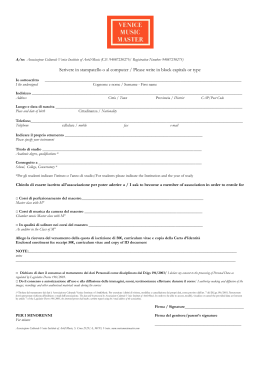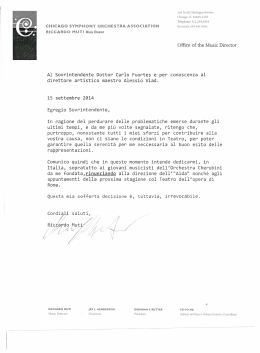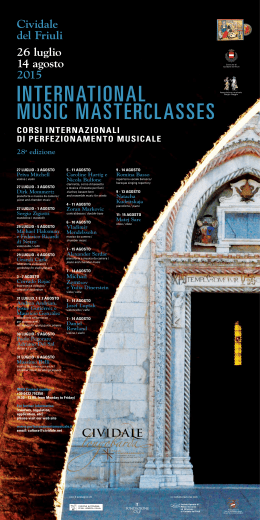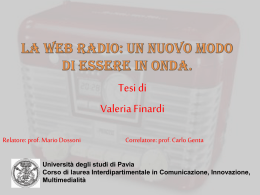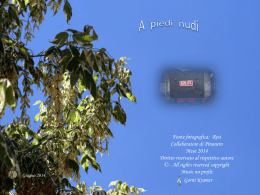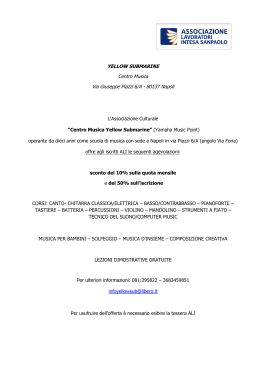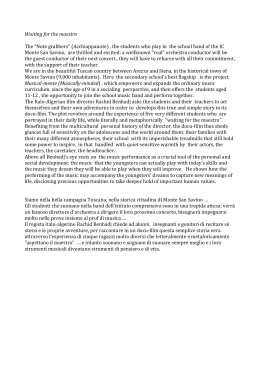Biagio Marini and the Meanings of Violin Music in the Early Seicento A Dissertation Presented to the Faculty of the Graduate School of Yale University in Candidacy for the Degree of Doctor of Philosophy by Rebecca Schaefer Cypess Dissertation Director: Dr. Ellen Rosand May, 2008 UMI Number: 3317261 Copyright 2008 by Cypess, Rebecca Schaefer All rights reserved. INFORMATION TO USERS The quality of this reproduction is dependent upon the quality of the copy submitted. Broken or indistinct print, colored or poor quality illustrations and photographs, print bleed-through, substandard margins, and improper alignment can adversely affect reproduction. In the unlikely event that the author did not send a complete manuscript and there are missing pages, these will be noted. Also, if unauthorized copyright material had to be removed, a note will indicate the deletion. ® UMI UMI Microform 3317261 Copyright 2008 by ProQuest LLC. All rights reserved. This microform edition is protected against unauthorized copying under Title 17, United States Code. ProQuest LLC 789 E. Eisenhower Parkway PO Box 1346 Ann Arbor, Ml 48106-1346 © 2008 by Rebecca Lynn Cypess All rights reserved. Acknowledgements I would like to offer my thanks to several people without whom this dissertation could not have been completed. First, Ellen Rosand has been enormously supportive through the duration of this project, offering advice, reading and editing drafts, providing honest responses, and teaching me how to write. Robert Holzer, too, was of great help in tracking down citations, translating difficult passages of poetry, and making suggestions about the course of the project. I owe a particular debt to Craig Wright, who has suggested ways in which my work might proceed in the future. Leon Plantinga, James Hepokoski, and Patrick McCreless have been tireless advocates and offered their kindness at many turns. My fellow graduate students provided ample feedback as well; in particular I'd like to thank Eric Bianchi, Sarah Van der Laan, Rebecca Tinio, Nathan Link, Pietro Moretti, Laura Weber, Angela Boerger, Paul Berry, Sarah Clemmens, Seth Monahan, and Cara Pickett. My professors at Cornell—especially Neal Zaslaw, James Webster, Rebecca Harris-Warrick, and Malcolm Bilson—have continued to be helpful mentors and friends after my departure from Ithaca. I also thank Donald Irving, my high school music teacher, who set me on this path years ago. My parents, Drs. David and Roberta Schaefer, to whom this dissertation is dedicated, have seen me through 26 years of education, making great personal sacrifices to ensure that I received every possible academic advantage. They have also been my strongest supporters. Like all children, I have no way of repaying them for all that they have given me, so the dedication of this work is merely a token. My grandparents, Zina and Murray Schaefer and Celia and Maurice Rubel, always met my enthusiasm for music with equal excitement. My sister Naomi, whose sharp mind and loving temperament enhanced my early education in life and academe, has continued to be a friend and help in our adult years. My parents-in-law, Drs. Raymond and Sandra Cypess, have made generous sacrifices on my behalf as well, offering advice on research-related matters, and most notably by offering their time and energy babysitting when I had conferences or work to attend to. I would like to note how fortunate I feel to have role models in three women—my mother, my mother-in-law, and my adviser—who earned their doctorates and were pioneers in their fields when women did not do such things. Finally, to my husband, Rabbi Joshua Cypess, and our two adorable children, Benjamin Mordechai and Joseph Moshe Eliezer: thank you. I am grateful for the joy, patience, and unconditional love that the three of you have brought into our house. May we go from strength to strength. To my parents, Drs. David and Roberta Schaefer, with thanks A Note on Style Throughout this dissertation, the following conventions of style have been adopted: 1. Formatting generally follows the Chicago Manual of Style (fifteenth edition). 2. In titles of books, articles, and musical compositions in Italian, French, and Spanish, only the first letter of the first word is capitalized 3. Titles of musical compositions have been capitalized, but genres have not. Thus the "Sonata variata" uses a capital letter, but non-specific use of the term "sonata" does not. The first word of the "Romanesca per violino solo" is capitalized, but reference to the romanesca progression in general is not. 4. Musical examples have been transcribed in modern clefs. Original beamings have been retained, but bar-lines have been introduced in some cases for ease of reading. 5. Note names have been italicized; references to key signatures have not. Table of Contents Introduction The Paradox of Instrumental Music I. The Ritual and the Fictional in Music II. The Search for Meaning in Instrumental Music of the Seicento 1 6 10 Part I: Challenging the Conventions of Vocal Music Chapter One Marini's Affetti musicali (1617) and the Performance of Instrumental Music in the Early Seicento 17 I. Theories of Musical Patronage 19 II. The Violin from Professional to Amateur Instrument 26 III. Evidence for the Amateur Status of the Violin from Marini's Opus 3 31 IV. The Development of the Violin the Sixteenth and Seventeenth Centuries 36 V. The Giunti as Arbiters of Musical Taste 43 VI. Evidence from Print Culture Concerning the Dissemination of Instrumental Music 47 VII. Analysis of the Affetti musicali 54 VIII. The Affetti musicali as an Agent in the Spread of the Violin among Amateurs 71 Chapter Two Marini's Madrigali et symfonie (1618): Challenging the Narrative Sequence I. Petrarch's Rerum vulgarium fragmenta as a Model for Volumes of Music II. The Vocal Portion of the Madrigali et symfonie: A Nod to the Lyric Sequence? III. Coherence in the Instrumental Portion of the Madrigali et symfonie IV. The Abandonment of Narrative 73 78 85 104 126 Part II: Adopting the Conventions of Vocal Music Chapter Three Recognition, Narrative, and Marini's Romanesca for Solo Violin (1620) I. Ambiguity in the Romanesca Progression 132 136 Youarereadingapreview.Wouldyouliketoaccessthefull-text? Accessfull-text Palisca, Claude. "The First Performance of Euridice." In Studies in the History of Italian Music and Music Theory. 432-51. Oxford: Oxford University Press, 1994. "Vincenzo Galilei and some Links between 'Pseudo-Monody' and Monody." In Studies in the History of Italian Music and Music Theory. 346-63. Oxford: Oxford University Press, 1994. — "Peri and the Theory of Recitative." In Studies in the History of Italian Music and Music Theory. 452-66. Oxford: Oxford University Press, 1994. Baroque Music. Prentice-Hall: Englewood Cliffs, 1981. Pennington, Neil D. The Spanish Baroque Guitar: With a Transcription ofDe Murcia 's Passacalles y obras. Ann Arbor: UMI Research Press, 1981. Peri, Jacopo. Preface to Le musiche sopra L 'Euridice. Florence, 1600. Translated in Margaret Murata, ed., Strunk's Source Readings in Music History: The Baroque Era, Revised Edition, Leo Treitler, General Editor. 659-60. New York: W. W. Norton & Company, 1998. Picone, Michelangelo. "Petrarch and the Unfinished Book." Annali d'ltalianistica: Petrarch and the European Lyric Tradition 22 (2004): 45-60. Pinnell, Richard T. Francesco Corbetta and the Baroque Guitar: With a Transcription of his Works. Ann Arbor: UMI Research Press, 1980. Piperno, Franco. "Marini, Biagio." Dizionario biografico degli italiani. Roma: Istituto della Enciclopedia Italiana, forthcoming. — "La Sinfonia Strumentale del Primo Seicento." Studi Musicali 4 (1975): 145-68 and 5 (1976): 95-142. Pirrotta, Nino. "Temperaments and Tendencies in the Florentine Camerata." In Music and Culture in Italy from the Middle Ages to the Baroque. 217-34. Cambridge: Harvard University Press, 1984. 217-34. Polk, Keith. German Instrumental Music of the Late Middle Ages: Players, Patrons, and Performance Practice. Cambridge: Cambridge University Press, 1992. Powers, Harold S. "Tonal Types and Modal Categories in Renaissance Polyphony." Journal of the American Musicological Society 34 (1981): 429-70. Predota , Georg A. "Towards a Reconsideration of the 'Romanesca': Francesca Caccini's Primo libro delle musiche and Contemporary Monodic Settings in the First Quarter of the Seventeenth Century." Recercare 5 (1993): 87-113. 341 Romano, Remigio, ed. Prima raccolta di bellissime canzonette musicali, e moderne: di auttori grauissimi nellapoesia, & nella musica. Venice: Salvadori, 1618. Rooley, Anthony. "Ficino, and the Supremacy of Poetry over Music." In Le concert des Voix et des Instruments a la Renaissance: Actes du XXXIVe Colloque International d'Etudes Humanistes, Tours, Centre d'Etudes Superieures de la Renaissance, 1-11 juillet 1991,, edited by Jean-Michel Vaccaro. 51-6. Paris: CNRS, 1995. Rosand, Ellen. "Senza Necessita del Canto dell'Autore: Printed Singing Lessons in Seventeenth-Century Italy." In Atti del XIV Congresso della Societa Internazionale di Musicologia, Bologna, 1987: Trasmissione e Recezione delle Forme di Cultura Musicale, 214-24. Torino: Edizioni di Torino, 1990. — "The Descending Tetrachord: An Emblem of Lament." The Musical Quarterly 65/3 (July, 1979): 346-59. Rovighi, Luigi. "Violino populare e violino barocco: quadro dei rapporti fra due linguaggi e due prassi." In Strumenti musicali e tradizionipopolari in Italia, edited by R. Leydi and F. Guizzi. Rome: Bulzoni Editore, 1985. Sarcina, Paola. "Gli strumenti musicali nel trattati italiani del XVI secolo: da Giovanni Maria Lanfranco a Scipione Cerreto." In Los Instrumentos Musicales en el Sigh XVI. Avila, Spain: Fundacion Cultural Santa Teresa, 1997. Saunders, Steven. Cross, Sword, and Lyre: Sacred Music at the Imperial Court of FerdinandIIof Habsburg (1619-1637). Oxford: Clarendon Press, 1995. Schulze, Hendrik. "Of Dancing Stars and Dukes - French Influences on Dance and Instrumental Music at the Court of Modena in the late Seventeenth Century." Paper presented at the annual meeting of the Society for Seventeenth-Century Music, South Bend, IN, 2006. Selfridge-Field, Eleanor. Venetian Instrumental Music from Gabrieli to Vivaldi. Oxford: Blackwell, 1975; New York: Dover, 1994/R. "Biagio Marini and Brescian Instrumental Music." In Liuteria e musica strumentale a Brescia tra Cinque e Seicento. Brescia, Italy: Fondazione Civilta Bresciana, 1992. 2 vols. "Canzona and Sonata: Some Differences in Social Identity." International Review ojthe Aesthetics and Sociology oj'Music 9/1 (1978): 111-119. — "Dario Castello: A Non-Existent Biography." Music and Letters 53/2 (1972): 179-90. 342 Sella, Domenico. "The Survival of the Urban Economies of Central and Northern Italy in the Seventeenth Century: Recent Studies and New Perspectives." Journal of Mediterranean Studies 10/1-2 (2000): 275-85. Italy in the Seventeenth Century. London: Longman, 1997. Steinzor, C.E. "Dance Music Published in Italy, 1600-40." Ph.D. Diss., State University of New York at Buffalo, 1996. Sutton, Julia. "Dance: Before 1630" Grove Music Online ed. L. Macy (Accessed 8/23/05), http://www.grovemusic.com. Tasso, Torquato. Jerusalem Delivered: Gerusalemme Liberata, edited and translated by Anthony M. Esolen. Baltimore: Johns Hopkins University Press, 2000. Treadwell, Nina. "Guitar Alfabeto in Italian Monody: The Publications of Alessandro Vincenti." Journal of the Lute Society 33 (1993): 12-22. Tyler, James. "The Role of the Guitar in the Rise of Monody: The Earliest Manuscripts." Journal of Seventeenth-Century Music 9/1 (2003). and Paul Sparks, The Guitar and its Music from the Renaissance to the Classical Era. Oxford: Oxford University Press, 2002. Waldoff, Jessica. Recognition in Mozart's Operas. Oxford: Oxford University Press, 2006. Walker, Thomas. "Ciaccona and Passacaglia: Remarks on their Origin and Early History." Journal of the American Musicological Society 21/3 (1968): 300-20. Ward, John. "The Manner of Dauncynge." Early Music 4/2 (April, 1976): 127-42. Weinberg, Bernard. A History of Literary Criticism in the Italian Renaissance. Chicago: University of Chicago Press, 1963. 2 vols. Whenham, John. Duet and Dialogue in the Age of Monteverdi. Ann Arbor: UMI Research Press, 1982. Witten II, Laurence C. "Apollo, Orpheus, and David: A Study of the Crucial Century in the Development of Bowed Strings in North Italy 1480-1580 as Seen in Graphic Evidence and some Surviving Instruments." Journal of the American Musical Instrument Society 1 (1975) 5-55. Wright, Elisabeth. "Marino and Music: A Marriage of Expressive Rhetorical Gesture." In The Sense of Marino: Literature, Fine Arts, and Music of the Italian Baroque, ed. Francesco Guardiani. New York: Legas, 1994. 343 Music Cited Bernardi, Stefano. Madrigaletti a due et a tre voci con alcune sonate. Venice: Vincenti, 1621. Motetti in cantilena a quattro voci. Con alcune canzoni per sonare con ogni sorte di stromenti, con il basso per Vorgano. Venice: Vincenti, 1613. Bononcini, Giovanni Maria. Variifiori del giardino musicale overo sonata da camera a 2, 3. e 4. col suo basso continuo, & aggiunta d'alcuni canoni studiosi, & osseruati. Bologna: Monti, 1669. Brunelli, Antonio. Scherzi, arie, canzonette, madrigali a una, due e tre voci: per cantare sul chittarone & stromenti simili. Libro terzo. Venice: Vincenti, 1616. Busatti, Cherubino. Arie a voce sola. Venice: Vincenti, 1638. Caccini, Francesca. Primo libro delle musiche. Florence: Pignoni, 1618. Modern edition of the secular songs by Ronald James Alexander and Richard Savino, Bloomington: Indiana University Press, 2004. Callon, Gordon, ed. Songs with Theorbo (ca. 1650-1663). Madison: A-R Editions, 2000. Castello, Dario. Sonate concertate in stil moderno per sonar nel organo overo spineta con diversi instrumenti libro secondo. Venice: Magni, 1629, R/1644. Sonate concertate in stil moderno per sonar nel organo overo spineta con diversi instrumenti. Venice: Magni, 1621 [lost] R/1629, 1658. Facsimile of 1658 edition, Florence: Studio per Edizioni Scelte, 1981. Cifra, Antonio. Li Diversi scherzi...libro secondo. Rome: Robletti, 1613. — Li Diversi scherzi...libro quarto. Rome: Robletti, 1615. Cima, Giovanni Paolo. Concerti ecclesiastici a. 1. 2. 3. 4. 5. & 8. voci. Messa, e doi Magnificat, & falsi bordoni a 4 & sei sonate, per instrumenti a due, tre, e quatro. Milan: Tini & Lomazzo, 1610. Facsimile with introduction by Piero Mioli, Florence: Studio per Edizioni Scelte, 1986. Corbetta, Francesco. Varii capriciiper la ghittara spagnuola. Milan, 1643. Facsimile, Florence: Studio per Edizioni Scelte, 1980. Farina, Carlo. Ander Theil newer Paduanen, Gagliarden, Couranten, franzosischen Arien, benebenst einem kurtzweiligen Quodlibet. Dresden: Gimel Bergen, 1627. Edition of the "Capriccio stravagante" by Gunther Schtiller, New York: Associated Music Publishers, 1982. 344 Frescobaldi, Girolamo. Secondo libro d'arie musicaliper cantarsi. Rome: Landini, 1630. Gabrieli, Giovanni. Canzoni et sonate. Venice: Magni, 1615. Granata, Giovanni Battista. Nuova scielta di capricci armonici e suonate musicali in vari tuoni. Bologna, 1651. Soavi concenti di sonate musicali per la chitarra spagnuola. Bologna: Monti, 1659. Facsimile edition with introduction by James Tyler, Monte Carlo: Editions Chanterelle, 1979. d'India, Sigismondo. Musiche a due voci. Venice: Amadino, 1615. Landi, Stefano. II S. Alessio Dramma Musicale. Rome: Masotti, 1634. Facsimile edition, Bologna: Forni, 1970. Lappi, Pietro. Sacrae melodiae unica, duabus, tribus quatuor, quinque, nee non, & sex vocibus decantande, una cum simphonijs, & bassus ad organum. Venice: Amadino, 1614. Marini, Biagio. Per ogni sorte di stromento musicale diversi generi di sonate, da chiesa, e da camera, a due, tre & a quattro con I 'alfabeto alle piu proprie, per la chitarra alia spagnola a beneplacito. Libro terzo. Venice: Magni, 1655. Facsimile edition, Florence: Studio per Edizioni Scelte, 1979. Modern edition with introduction by Ottavio Beretta. Milan: Edizioni Suvini Zerboni, 1997. Salmi per tutte le solennita dell'anno concertati nel moderno stile ad una due e tre voci con violini e senza. Venice: Magni, 1653. The partbooks for the alto and second violin are not extant. Excerpts in Thomas Dunn, ed. Biagio Marini: Music for Vespers (Web Library of Seventeenth-Century Music, 2004). http://aaswebsv.aas.duke.edu/wlscm/MariniVespers/Opl 8&20.html Compositioni varie per musiche di camera. Venice: Vincenti, 1641. —Sonate, symphoniae, canzoni, pass 'emezzi, baletti, corenti, gagliarde, & retornelli, a 1. 2. 3. 4. 5. & 6. voci, per ogni sorte d'instrumenti. Un capriccio per sonar due violini quatro parti. Un ecco per tre violini & alcune sonate capricciose per sonar due e tre parti con il violino solo, con altre curiose & moderne inventione. Opera ottava. Venice: Magni, ded. 1626. Facsimile reprint, Florence: Studio per Edizioni Scelte, 2004. Modern edition by Maura Zoni. Milan: Edizioni Suvini Zerboni, 2004. —Madrigaletti a una due tre e quatro voci, con alcune vilanelle per cantare nella chitariglia spagnola chitarone o altro simile instromenti. Venice: Magni, ded. 1625. 345 — -Per le musiche da camera: Concert! a quattro, cinque, sei voci e instromenti. Venice: Magni, ded. 1624. Ze Lagrime d 'Erminia in stile recitativo, con alcune ode da cantarsi con termine affettuoso nel chitarone, clavicordo, o altro stromento simile. Parma: Viotti, 1623. Facsimile reprint, Bologna: S.I.R.A.B, 1971. Scherzi e canzonette a una, e due voci...accommodate da cantarsi nel chitarone, chitariglia & altri stromenti simili; con i suoi ritornelliper il violino, e chitarone. Parma: Viotti, 1622. Facsimile edition with introduction by Piero Mioli. Florence: Studio per Edizioni Scelte, 1980. -Arie madrigali e corenti a 1, 2, 3. Venice: Bartholomeo Magni, 1620. Facsimile reprint, Milan: AMIS, 1970. Madrigali et symfonie. Venice: Magni, 1618. Excerpts in Thomas Dunn, ed., Biagio Marini, Madrigali e Symfonie, Op. 2. 2 nd edition. Web Library of Seventeenth-Century Music, www.sscm.wlscm.org (January, 2005). Affetti musicali. Modern edition with introduction by Franco Piperno, Milan: Edizioni Suvini Zerboni, 1990. Merula, Tarquinio. Canzoni, overo sonate concertate per chiesa, e camera a due et a tre...libro terzo. Venice: Alessandro Vincenti, 1637. Modern edition by Adam Sutkowski in Tarquinio Merula: Opere Complete. Brooklyn: Institute of Mediaeval Music, 1974-. Milanuzii, Carlo. Quarto scherzo delle ariose vaghezze. Venice: Vincenti, 1624. Secondo scherzo delle ariose vaghezze. Venice: Vincenti, 1622. Monteverdi, Claudio. Madrigali Guerrieri, et Amorosi con alcuni opuscoli in genere rappresentativo, che saranno per brevi Episodii fra i canti senza gesto. Libro ottavo. Venice: Vincenti, 1638. Modern edition in G. Francesco Mailipiero, ed., Tutte Le Opere di Claudio Monteverdi. Asolo, 1926-46. Reprinted with introduction by Stanley Appelbaum, New York: Dover, 1991. Concerto: Settimo libro de madrigali, con altri generi de canti. Venice: Magni, 1619). Modern edition in G. Francesco Mailipiero, ed., Tutte Le Opere di Claudio Monteverdi. Asolo, 1926-46. Ortiz, Diego. Tratado de glosas sobre clausulasy otros generos de puntos en la musica de violones. Rome, 1553. Modern edition by Annette Otterstedt, Kassel: Barenreiter, 2003. 346 Rossi, Salamone. // terzo libro de varie sonate, sinfonie, galiarde, brandi e corrente per sonar due viole da braccio, & un chittarrone, o altro stromento simile (Venice: Vincenti, 1613 [lost] R/1623). Modern edition by Don Harran in Salamone Rossi, Complete Works. Neuhausen: American Institute of Musicology, 1995-. Turini, Francesco. Madrigali a una, due, e tre voci con alcune sonate. Venice: Vincenti, 1621. Uccellini, Marco. Sonate, arie et correnti. Venice: Vincenti, 1642. Valentini, Giovanni. Musiche di camera. Venice: Vincenti, 1621. Vincenti, Alessandro, ed. Arie de diversi Venice: Vincenti, 1634. Zannetti, Gasparo. II Scolaro per imparare a suonare di violino, et altri stromenti. Milan: Camagno, 1645. Facsimile edition, Florence: Studio per Edizioni Scelte, 1984. 347
Scarica
